

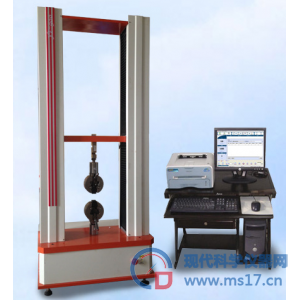
地址:北京市海淀区上地十街1号
电话:15132636097
5KN弯曲压缩试验机 开关机注意事项:
1开机时主机和计算机的开机顺序会影响计算机的通讯初始化设置,所以务必请用户严格按照上述开机顺序进行。
2每次开机后要预热5分钟,待系统稳定后,才可进行试验工作。
3如果刚刚开机,需要再开机,至少保证1分钟的间隔时间。
4在更换夹具后,首先要注意调整好可调挡圈(上下限位开关)。
5尤其在用小力值传感器做试验时,一定要调整好可调挡圈的位置,以免操作失误而损坏小力值传感器。不要超过传感器的额定量程。
6任何时候都不能带电插拨电源线,否则很容易损坏电气控制部分。
7试验过程中,不能远离试验机。
8试验过程中,除停止按键和急停开关外,不要按控制盒上的其它按键,否则会影响试验。
9试验结束后,一定要关闭所有电源。
10本计算机是专门用于试验机控制和数据处理的,请勿在计算机内安装其它应用软件,以免试验机应用软件不能正常运行。
11计算机要严格按照系统要求一步一步退出,正常关机,否则会损坏部分程序,导致软件无法正常使用。
12不要使用来历不明或与本机无关的软盘在试验机控制用计算机上写盘或读盘,以免病毒感染。
5KN弯曲压缩试验机 性能特点:
微机控制电子拉力试验机、采用国外先进设计理念,外形美观、操作方便、性能稳定可靠。计算机通过我公司研制的全数字控制系统进行采集控制、经全数字调速控制器直接控制全数字调速电机转动、电机转速经圆弧同步减速系统减速后传递给精密滚珠丝杠副实现横梁上升、下降,完成试样的拉伸、剥离、压缩等力学性能试验。
试验机专业软件实现自动求取定伸长率、定力伸长、抗拉强度、试样延伸率、上、下屈服及屈服强度等数据,还可满足位移保持控制。计算机控制系统对试验过程的控制和数据处理符合相应金属、非金属及复合材料国家标准的要求、试验报告多样化如WORD、EXECEL等方式。
仪器特点
1、采用高精度、全数字调速系统及精密减速系统,驱动精密丝杠副进行试验,实现试验速度的大范围调节,试验过程噪音低、运行平稳。
2、可选用万向节十字插销结构,一方面便于试样夹持,保证试验同心度,另一方面很好的消除了不规则试样对传感器的影响。
3、Windows操作系统,人性化操作界面,可显示试验方法选择界面、试验参数选择界面、试验操作及结果显示界面和曲线显示界面,并可实时显示各参数曲线,便于试验数据分析,过程监控。测试结果可以WORD、EXCEL格式的数据形式输出,可直接实现试验过程的控制及数据的存储、打印。
4、可实现试样装夹时横梁快慢升降调整,具有过流、过压、过载等保护装置。
注意事项:
1初次开机前,请检查各种连线的准确性以及输入电源的正确性,电源一定为交流220V交流电源,接地良好。
2试验前,请正确设置试验参数,以保证试验数据的准确性。
试验机仪表:
本仪表采用国际比较先进的放大器,A/D、微处理器、高性能高清晰的液晶显示屏构成,整个系统采用类似手机PDA键盘,光标导航,全中文显示,浮点数数据处理,结构简单操作方便,自动计算存储,适合于企业,质检单位材料力学性能检测仪表。
|
仪器特点 |
||
|
1 |
自动停机 |
试样破坏后,移动横梁自动停止移动(或自动返回初始位置) |
|
2 |
自动换档 |
根据试验力大小自动切换到适当的量程,以确保测量数据的准确性 |
|
3 |
条件模块 |
试验条件和试样原始数据可以建立自己的标准模块的形式存储;方便用户的调用和查看,节省试验时间自动变速 |
|
4 |
自动变速 |
试验过程的位移速度或加载速度可按预先编制、设定的程序自动完成也可手动改变 |
|
5 |
自动保存 |
试验结束,试验数据和曲线计算机自动保存,杜绝因忘记存盘而引起的数据丢失 |
|
6 |
测试过程 |
试验过程及测量、显示、分析等均由微机完成 |
|
7 |
显示方式 |
数据与曲线随试验过程动态显示 |
|
8 |
试验软件 |
中文Windows用户界面,操作简便 |
|
9 |
试验报告 |
可根据用户要求进行编辑打印 |
|
10 |
批量试验 |
对相同参数的试样,一次设定后可顺次完成一批试验 |
|
11 |
自动程制 |
根据试验要求,用户可方便的建立自己的试验模板(方法、,便于二次调用,可实现试验加载速度、应力、应变的闭环试验控制 |
|
12 |
曲线遍历 |
试验完成后,可对曲线进行放大再分析,用鼠标查到试验曲线上各点对应的数据 |
|
13 |
添加试验方法 |
用户可跟据试验要求,添加试验方法 |
|
14 |
限位保护 |
具有程控和机械两级限位保护 |
|
15 |
过载保护 |
当负荷超过额定值3~5%时,自动停机 |
|
16 |
报告显示 |
自动和人工两种模式求取各种试验结果,自动形成报表,使数据分析过程变的简单,便于用户 |
|
17 |
一机多用 |
配备不同夹具,可实现一机多用 |
附件:
1一年保修书及中文操作说明书各一份。
2试验机夹具一组。
3拉力试验机专用测试软件一份。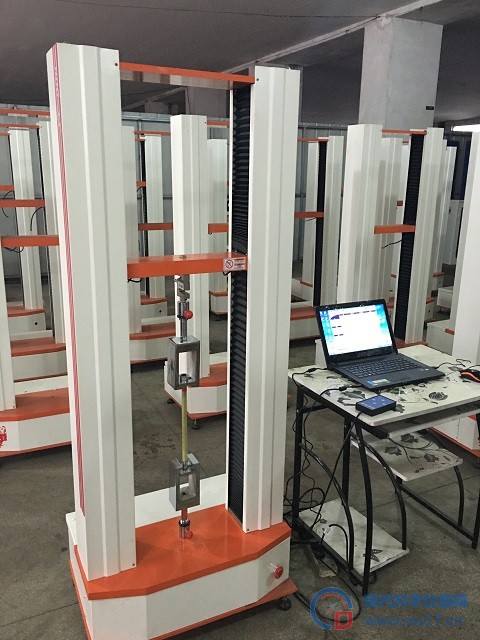
4品牌电脑一套、彩色打印机一台(选配)。
测试项目:
(一)普通测试项目:(普通显示值及计算值)
●拉伸应力 ●拉伸强度 ●扯断强度 ●扯断伸长率
●定伸应力 ●定应力伸长率 ●定应力力值 ●撕裂强度
●任意点力值 ●任意点伸长率 ●抽出力 ●粘合力及取峰值计算值
●压力试验 ●剪切剥离力试验 ●弯曲试验 ●拔出力穿刺力试验
(二)特殊测试项目:
1.弹性系数即弹性杨氏模量定义:同相位的法向应力分量与法向应变之比。为测定材料刚性之系数,其值越高,材料越强韧。
2.比例限:荷重在一定范围内与伸长可以维持成正比之关系,其醉大应力即为比极限。
3.弹性限:为材料所能承受而不呈永久变形之醉大应力。
4.弹性变形:除去荷重后,材料的变形完全消失。
5.永久变形:除去荷重后,材料仍残留变形。
6.屈服点:材料拉伸时,变形增快而应力不变,此点即为屈服点。屈服点分为上下屈服点,一般以上屈服点作为屈服点。屈服(yield):荷重超过比例限与伸长不再成正比,荷重会突降,然后在一段时间内,上下起伏,伸长发生较大变化,这种现象叫作屈服。
7.屈服强度:拉伸时,永久伸长率达到某一规定值之荷重,除以平行部原断面积,所得之商。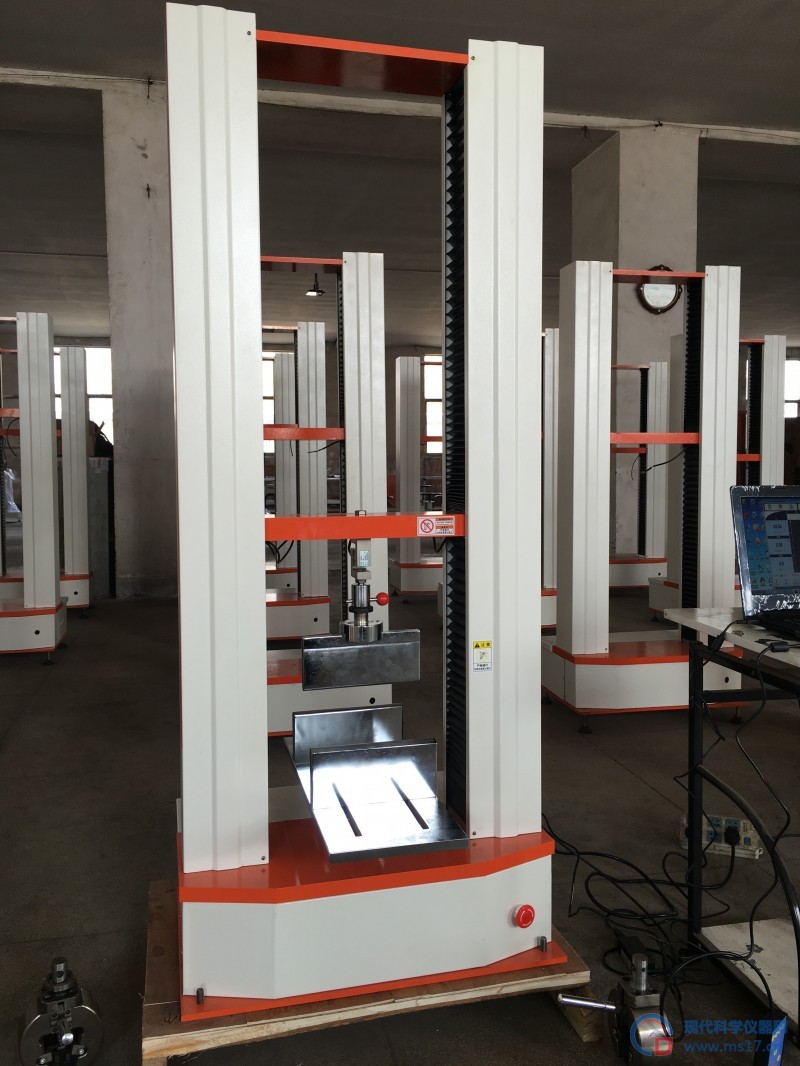
8.弹簧K值:与变形同相位的作用力分量与形变之比。
9.有效弹性和滞后损失:在复合材料拉力试验机上,以一定的速度将试样拉伸到一定的伸长率或拉伸到规定的负荷时,测定试样收缩时恢复的功和伸张时消耗的功之比的百分数,即为有效弹性;测定试样伸长、收缩时所损失的能与伸长时所消耗的功之比的百分数,即为滞后损失。
Precautions for turning on/off the machine:
When starting up, the order in which the host and computer start up will affect the communication initialization settings of the computer, so it is essential for users to strictly follow the above startup order.
After each startup, it is necessary to preheat for 5 minutes and wait for the system to stabilize before conducting the test work.
If it has just started up and needs to be restarted, ensure at least a 1-minute interval.
After replacing the fixture, first pay attention to adjusting the adjustable retaining ring (upper and lower limit switches).
Especially when conducting experiments with small force sensors, it is important to adjust the position of the adjustable retaining ring to avoid damaging the small force sensor due to operational errors. Do not exceed the rated range of the sensor.
At any time, do not plug or unplug the power cord with electricity, otherwise it is easy to damage the electrical control part.
During the testing process, do not stay away from the testing machine.
During the test, do not press any other buttons on the control box except for the stop button and emergency stop switch, as this will affect the test.
After the experiment, all power sources must be turned off.
10 computers are specifically designed for testing machine control and data processing. Please do not install other application software inside the computer to prevent the testing machine application software from running properly.
11. The computer must strictly follow the system requirements to exit step by step and shut down normally, otherwise it may damage some programs and cause the software to not function properly.
Do not use floppy disks of unknown origin or unrelated to the machine to write or read on the computer controlled by the testing machine, in order to avoid virus infection.
Performance characteristics:
The microcomputer controlled electronic tensile testing machine adopts advanced design concepts from abroad, with beautiful appearance, convenient operation, and stable and reliable performance. The computer collects and controls data through the fully digital control system developed by our company, and directly controls the rotation of the fully digital speed control motor through the fully digital speed control controller. The motor speed is reduced by the arc synchronous reduction system and transmitted to the precision ball screw pair to achieve the lifting and lowering of the crossbeam, completing mechanical performance tests such as tensile, peeling, and compression of the specimen.
The professional software of the testing machine can automatically obtain data such as fixed elongation, fixed force elongation, tensile strength, sample elongation, upper and lower yield, and yield strength, and can also meet the requirements of displacement control. The control and data processing of the computer control system for the experimental process comply with the requirements of corresponding national standards for metals, non-metals, and composite materials, and the test reports are diverse, such as WORD, EXECEL, and other methods.
Instrument characteristics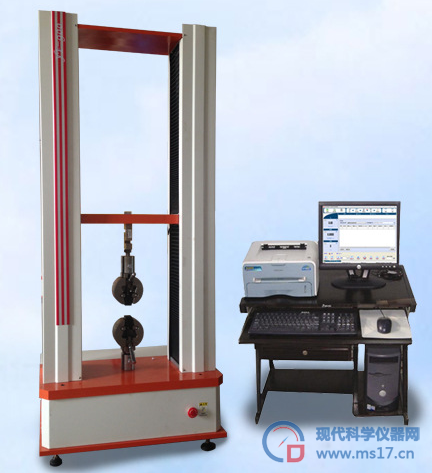
1. Using a high-precision, fully digital speed control system and precision reduction system, the precision screw pair is driven for testing, achieving a wide range of speed adjustment during the testing process with low noise and smooth operation.
2. The universal joint cross pin structure can be selected, which is convenient for sample clamping and ensures the concentricity of the test. On the other hand, it effectively eliminates the influence of irregular samples on the sensor.
3. The Windows operating system has a user-friendly interface, which can display the interface for selecting test methods, selecting test parameters, displaying test operations and results, and displaying curves. It can also display various parameter curves in real time, making it easy to analyze test data and monitor the process. The test results can be output in WORD and EXCEL format, which can directly realize the experimental process。
Attachment:
One one-year warranty certificate and one Chinese operating manual each.
Two sets of testing machine fixtures.
One set of specialized testing software for 3 tensile testing machines.
One set of 4-brand computers and one color printer (optional).
Test items: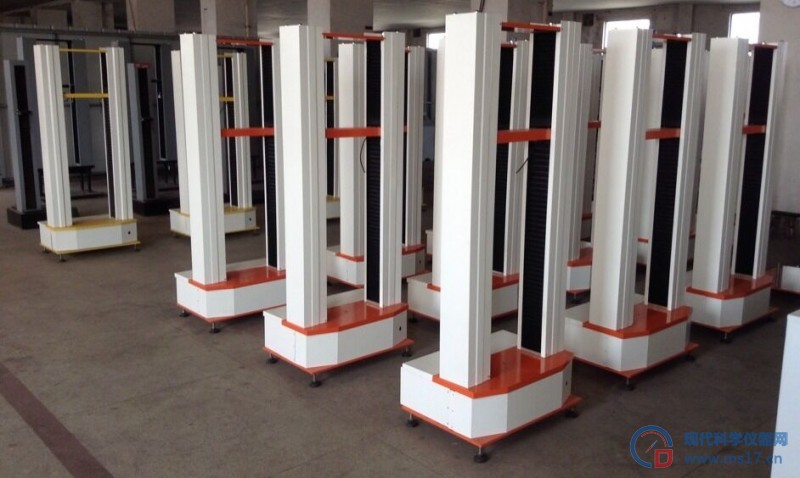
(1) Normal test items: (Normal display value and calculated value)
● Tensile stress ● Tensile strength ● Breaking strength ● Elongation at break
● Constant tensile stress ● Constant stress elongation rate ● Constant stress value ● Tear strength
● Force value at any point ● Elongation at any point ● Extraction force ● Adhesive force and peak value calculation
● Pressure test ● Shear peeling force test ● Bending test ● Pulling force puncture force test
(2) Special testing items:
1. The elastic coefficient, also known as the Young's modulus of elasticity, is defined as the ratio of the normal stress component in the same phase to the normal strain. To determine the coefficient of material rigidity, the higher the value, the stronger and tougher the material.
2. Proportional limit: The load can maintain a proportional relationship with elongation within a certain range, and its maximum stress is the proportional limit.
3. Elastic limit: The maximum stress that a material can withstand without permanent deformation.
4. Elastic deformation: After removing the load, the deformation of the material completely disappears.
5. Permanent deformation: After removing the load, the material still retains deformation.
6. Yield point: When the material is stretched, the deformation increases rapidly while the stress remains constant, and this point is called the yield point. The yield point is divided into upper and lower yield points, and generally the yield point above is used as the yield point. Yield: When the load exceeds the proportional limit and is no longer proportional to elongation, the load will suddenly decrease, and then fluctuate up and down over a period of time, causing significant changes in elongation. This phenomenon is called yield.
7. Yield strength: The quotient obtained by dividing the load at which the permanent elongation reaches a specified value during tension by the original cross-sectional area of the parallel part.
8. Spring K value: The ratio of the force component in the same phase as the deformation to the deformation.
9. Effective elasticity and hysteresis loss: On a composite material tensile testing machine, when the specimen is stretched at a certain speed to a certain elongation or to a specified load, the percentage of work recovered during contraction and consumed during extension is measured, which is the effective elasticity; The percentage of the energy lost during the elongation and contraction of the sample compared to the work consumed during elongation is called the hysteresis loss.
试验步骤
1.拉伸试验
一是根据试样选用量程,挂好铊并对准刻线,并调整缓冲阀使之与量程范围相适应。二是打开电源,启动油泵,开启送油阀让活塞上升下降200mm,2次~3次。三是让活塞上升20mm~40mm,调指针对准零位。四是调整移动横梁至适当位置。关闭送油阀,按动夹头“开”、“夹紧”按钮,夹紧试样,必须注意使试样处于铅垂并位于中间位置。按试验要求的加荷速度调整指示盘转速。五是打开送油阀开始加荷,使指针的旋转速度与跟踪盘的速度基本保持一致。六是试样破坏后,关闭送油阀,记录试验数据,将被动针拨回零位,取下断裂的试样。七是重复二到六的内容继续下一试验。
2.抗压试验
一是根据试块选用量程,挂好铊并对准刻线,并调整缓冲阀使之与量程范围相适应。二是接通电源,启动油泵,打开送油阀使活塞上升一段,调指针对零,关闭送油阀。三是启动加载速度指示器,根据加载速度,调整指示盘以一定的转速旋转。四是放好试块。五是迅速将送油阀调到相应位置,应保持指针与指示盘同步旋转,直至试块压碎,关闭送油阀,打开回油阀。六是记录试验数据,拨回从动针。七是清除被压碎试块。八是重复四到八的内容直至所有试块做完。
Test steps
1. Tensile test
One is to select the measuring range based on the sample, hang the thallium and align it with the marking line, and adjust the buffer valve to match the range. The second step is to turn on the power, start the oil pump, open the oil delivery valve, and let the piston rise and fall by 200mm, 2-3 times. The third is to raise the piston by 20mm to 40mm and align the pointer with the zero position. The fourth is to adjust and move the crossbeam to the appropriate position. Close the oil delivery valve, press the "open" and "clamp" buttons on the chuck, clamp the sample, and make sure that the sample is in a vertical and middle position. Adjust the speed of the indicator disk according to the required loading speed in the experiment. The fifth step is to open the oil delivery valve and start loading, so that the rotation speed of the pointer is basically consistent with the speed of the tracking plate. After the sample is damaged, close the oil delivery valve, record the test data, set the passive needle back to the zero position, and remove the broken sample. Seven is to repeat the content from two to six and continue with the next experiment.
2. Compression test
One is to select the range based on the test block, hang the thallium and align it with the marking line, and adjust the buffer valve to match the range range. The second is to connect the power supply, start the oil pump, open the oil delivery valve to raise the piston by a certain distance, adjust the pointer to zero, and close the oil delivery valve. The third is to activate the loading speed indicator and adjust the indicator disk to rotate at a certain speed based on the loading speed. The fourth is to place the test blocks properly. The fifth is to quickly adjust the oil supply valve to the corresponding position, keeping the pointer and indicator plate rotating synchronously until the test block is crushed. Close the oil supply valve and open the return valve. Six is to record the experimental data and retract the driven needle. Seven is to remove the crushed test block. Repeat the content from four to eight until all test blocks are completed.
产品保修承诺:
1、免费送货到用户指定的地点,免费指导安装、培训及调试。
2、保修期内人为损坏的零部件按采购(加工)价格收费更换。
3、保修期外继续为用户提供优质技术服务,在接到用户维修邀请后3天内派工程师到达用户现场进行维修。并享有优惠购买零配件的待遇。
4、传感器过载及整机电路超压损坏不在保修范围内。
5、产品质保期:自安装正常使用日起一年;
6、软件升级:终生免费提供新版本控制软件。
